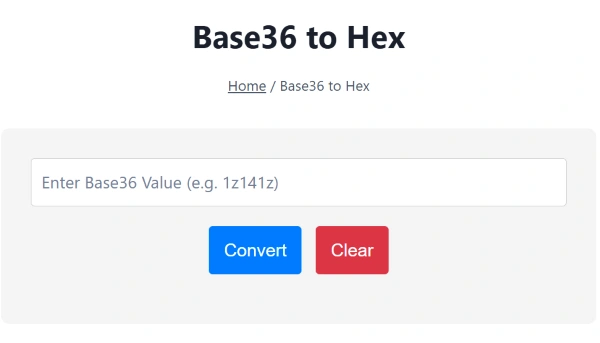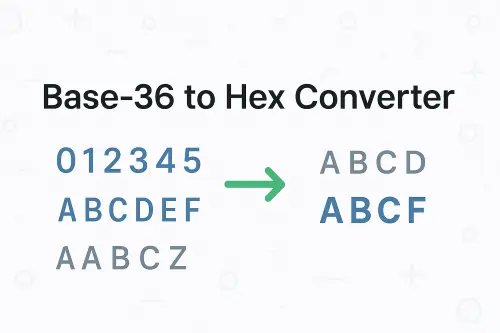Base36 to Hex
Reverse Conversion Tool: Hex to Base 36 Converter
Understanding Base-36 and Hexadecimal Systems
Base-36 System utilizes 36 unique symbols: digits 0-9 (representing values 0-9) and letters A-Z (representing values 10-35). This system creates compact, human-readable representations ideal for URL shortening, database identifiers, and alphanumeric encoding. Each position represents a power of 36, making calculations follow the formula: value = Σ(digit × 36^position).
Hexadecimal System uses 16 symbols: digits 0-9 and letters A-F (representing values 10-15). Widely used in programming and computing, hex provides an efficient bridge between human-readable notation and binary data. The hexadecimal calculator offers comprehensive hex arithmetic operations for advanced calculations.
The base36 to hex converter image is shown below:

Conversion Process and Examples

Converting base-36 to hexadecimal requires a two-step process: first convert to decimal, then to hexadecimal. This method ensures accuracy and reliability across all input types.
Step 1: Base-36 to Decimal For base-36 “1G”: (1 × 36¹) + (16 × 36⁰) = 36 + 16 = 52 decimal
Step 2: Decimal to Hexadecimal Convert 52 to hex: 52 ÷ 16 = 3 remainder 4, result = 34 hex
Common Conversion Examples:
- A (base-36) → A (hex)
- G (base-36) → 10 (hex)
- 1Z (base-36) → 47 (hex)
- ZZ (base-36) → 50F (hex)
The decimal to hex converter provides additional functionality for decimal-based conversions, while the hex to decimal tool enables reverse verification.

Practical Applications
Programming & Development
Many URL shorteners and API services use Base-36 identifiers that need hex formatting for hashing or cryptographic processing. Developers working with encoded text may also need the ASCII to Hex Converter or Hex to ASCII Tool for character-level transformations. When dealing with network-based identifiers, system engineers often rely on the IP to Hex and Hex to IP Converter.
Data Processing
ETL pipelines often encounter Base-36 identifiers exported from legacy systems. Converting them to hexadecimal lets analysts integrate them with binary or UTF-8 pipelines using tools like UTF8 to Hex and Hex to UTF8 Converter.
For older mainframe data, the EBCDIC to Hex and Hex to EBCDIC Converter ensure compatibility.
Web Development
Some web applications use Base-36 codes for color references, user IDs, or hashed tokens. Converting them to hex enables seamless integration with JavaScript, CSS, and log-tracking workflows. Developers who manipulate numeric formats may also find the Hex to Base64 and Base64 to Hex Converter useful for encoding layers.
Related Number Base Conversions
Our converter integrates seamlessly with other base conversion tools. The binary to hex and hex to binary converters handle binary data transformations, while hex to octal and octal to hex tools provide octal system compatibility.
For text processing applications, ASCII to hex and hex to ASCII converters enable character encoding transformations. Network administrators benefit from hex to IP and IP to hex tools for address manipulation.
Advanced Features and Usage
Input Validation: Our converter accepts all valid base-36 characters (0-9, A-Z) with automatic case normalization. Real-time validation prevents errors while supporting fractional and negative numbers.
Output Options: Results display in both uppercase and lowercase hex formats with decimal equivalents for verification. Copy-to-clipboard functionality streamlines workflow integration.
Batch Processing: Convert multiple base-36 values simultaneously with CSV import/export capabilities for large datasets. Error handling ensures smooth processing even with mixed data quality.
Mathematical Foundation
The conversion algorithm implements precise mathematical operations without approximation. For integer inputs, accuracy is guaranteed within computational limits. Fractional numbers maintain high precision suitable for engineering and scientific applications.
Algorithm Steps:
- Normalize input and validate characters
- Convert each character to numerical value (A=10, B=11, etc.)
- Apply positional notation: sum(digit_value × 36^position)
- Convert decimal result to hex using division algorithm
- Format output according to user preferences
Encoding Integration
Modern applications require multiple encoding format support. The hex to base 64 and base 64 to hex converters provide seamless integration with web protocols and data transmission standards.
FAQs About Base36 to Hex
Q: What’s the maximum value I can convert?
A: The converter handles extremely large base-36 values limited by system memory rather than algorithmic constraints, suitable for all practical applications.
Q: Can I convert negative numbers?
A: Yes, negative base-36 numbers are fully supported using standard minus sign notation (-1A2B).
Q: How accurate are the conversions?
A: Integer conversions achieve perfect mathematical accuracy. Fractional numbers maintain precision suitable for professional applications.
Q: What applications use base-36?
A: URL shortening services, database identifiers, gaming platforms, and social media content references commonly employ base-36 encoding.
